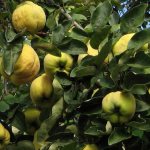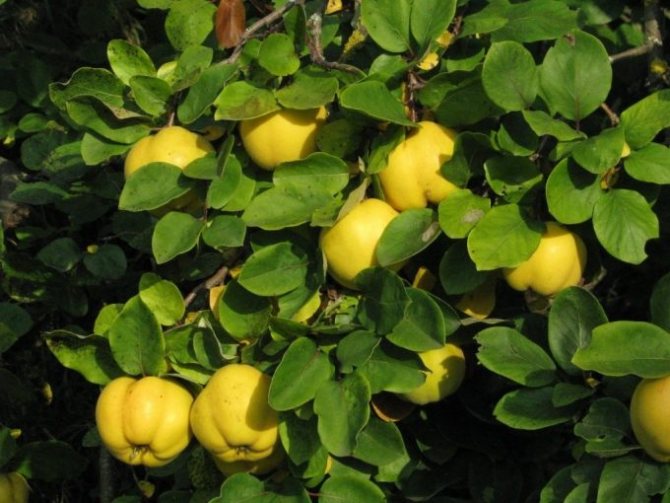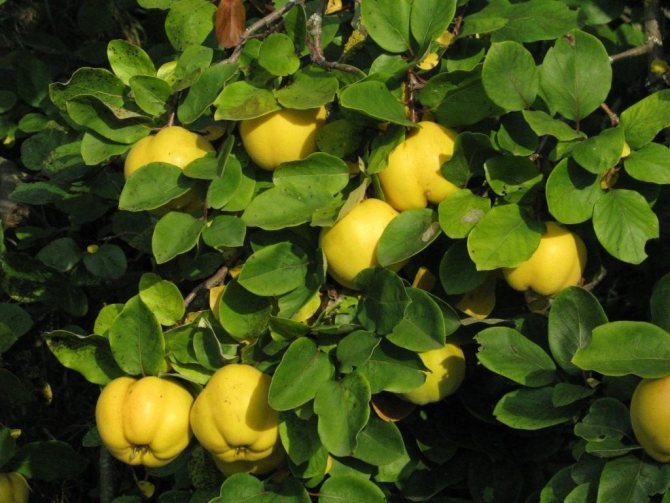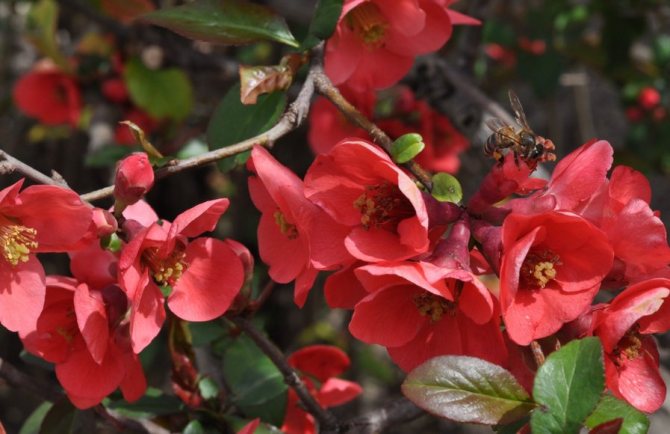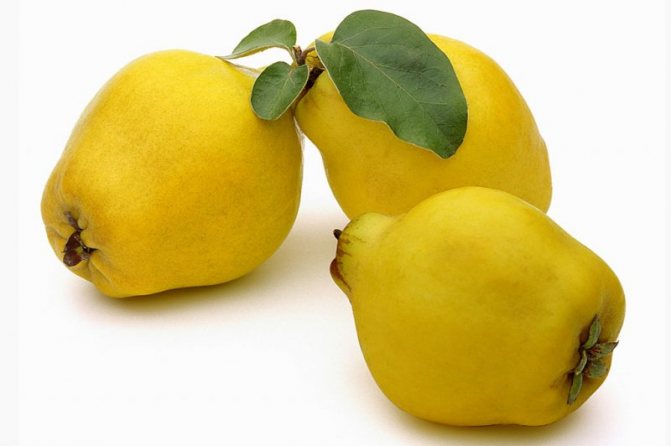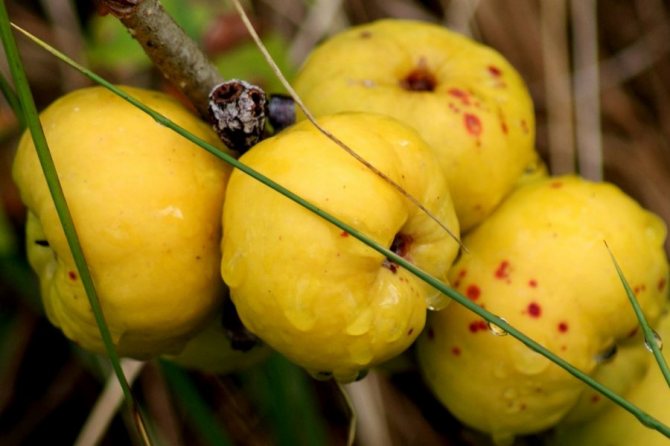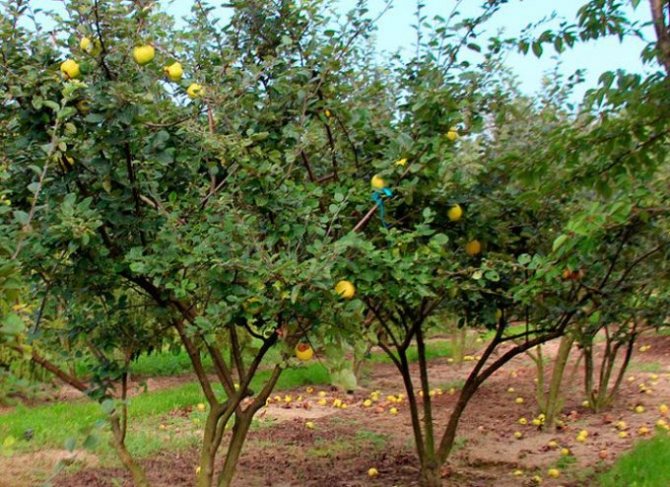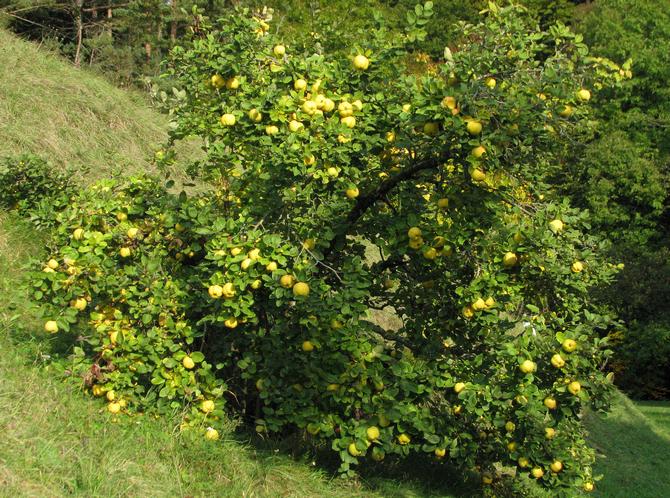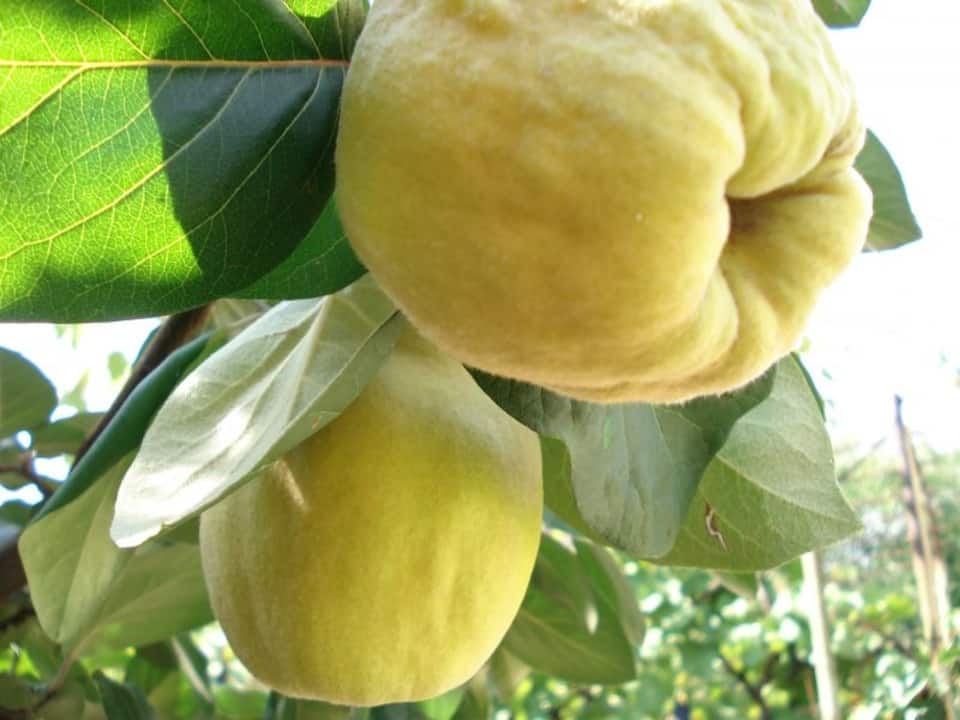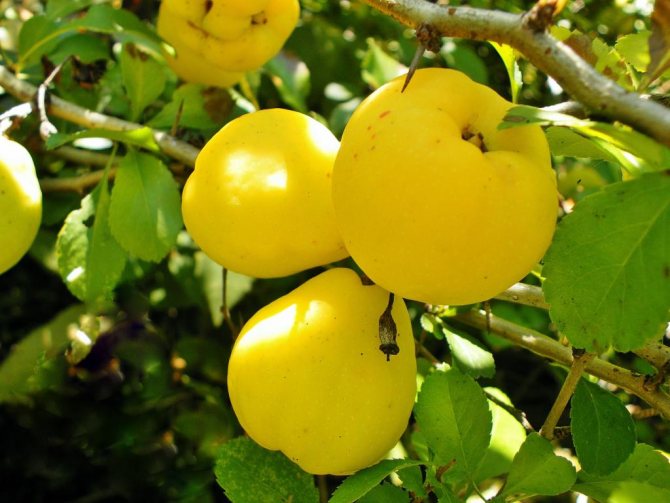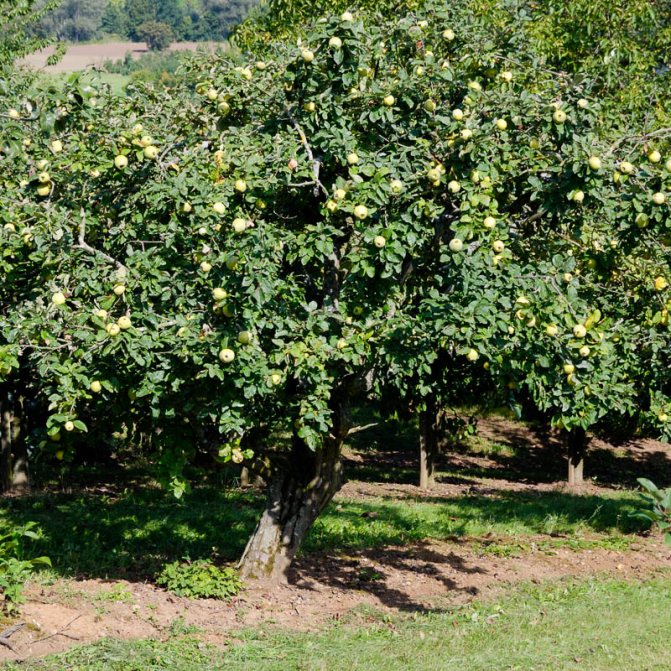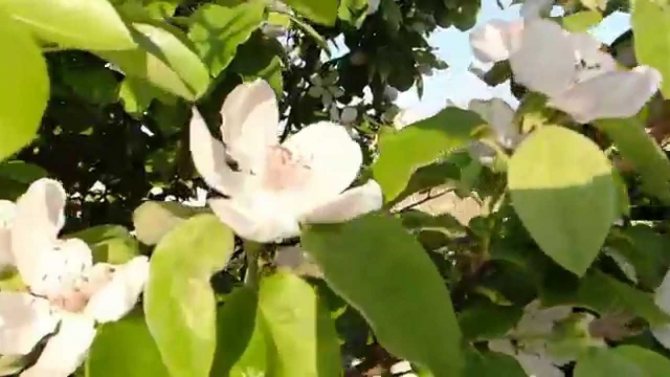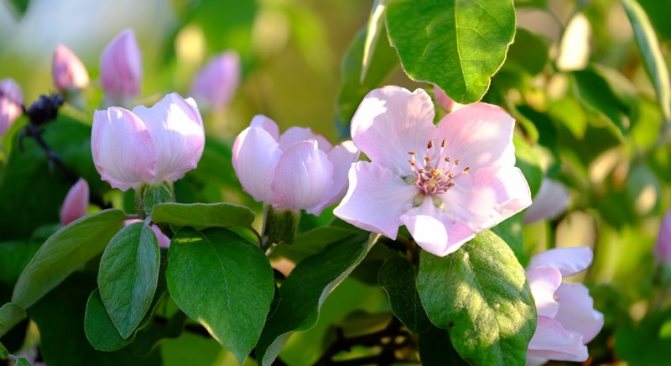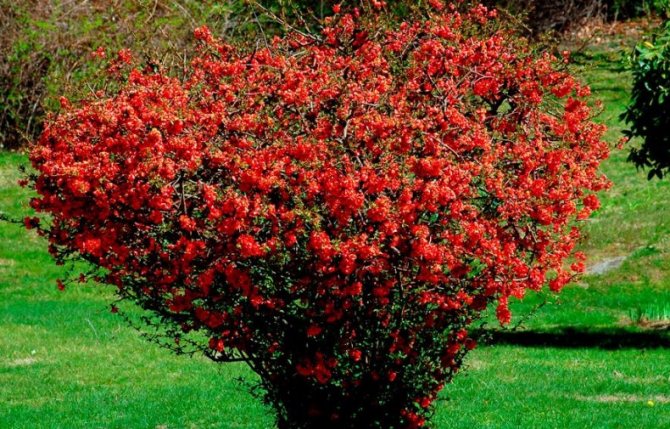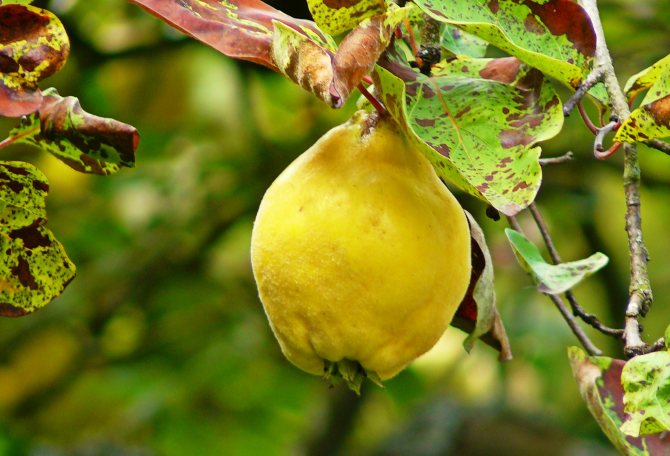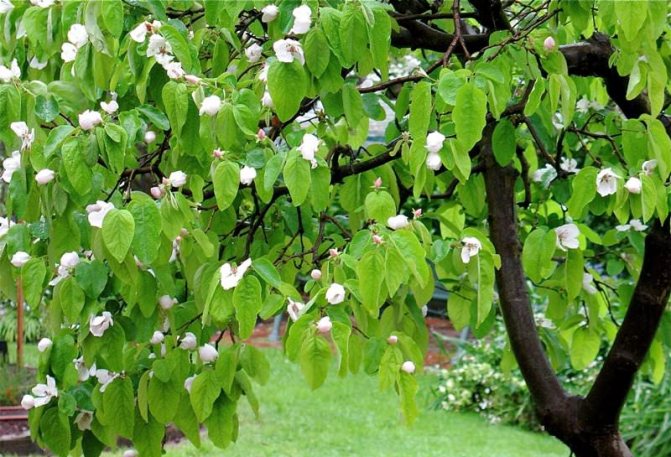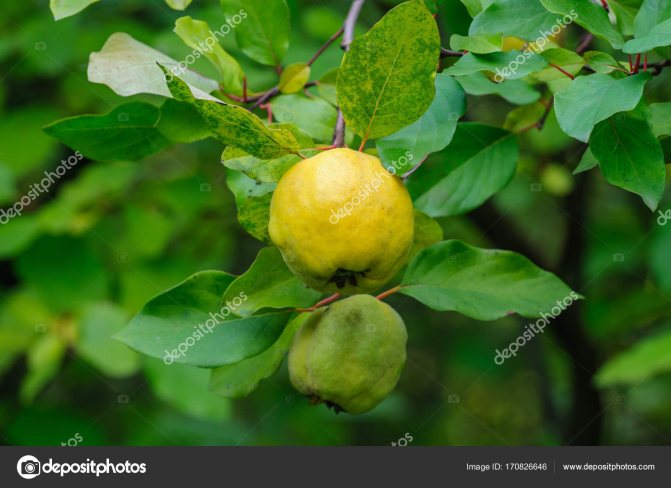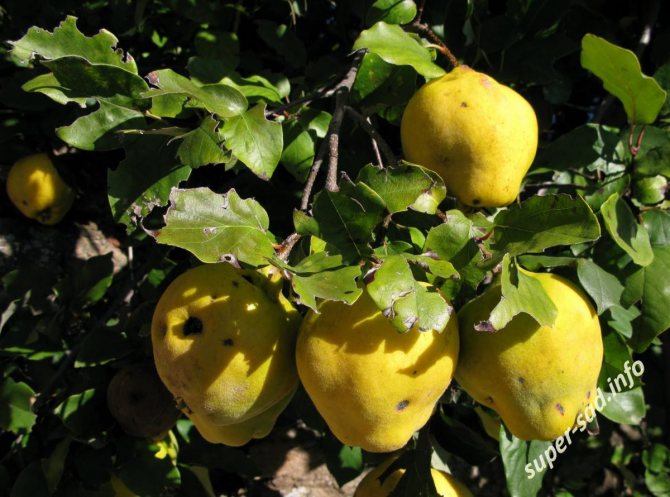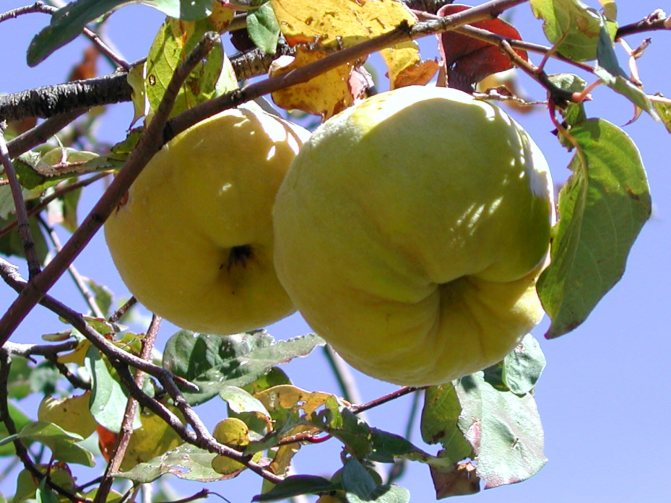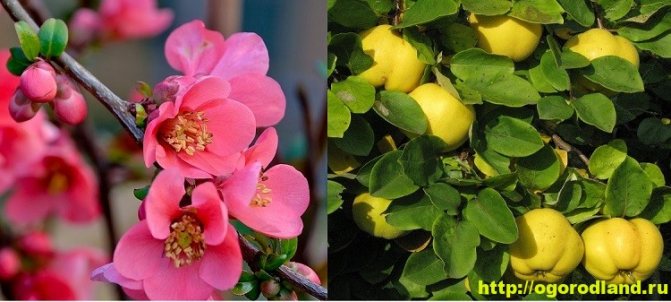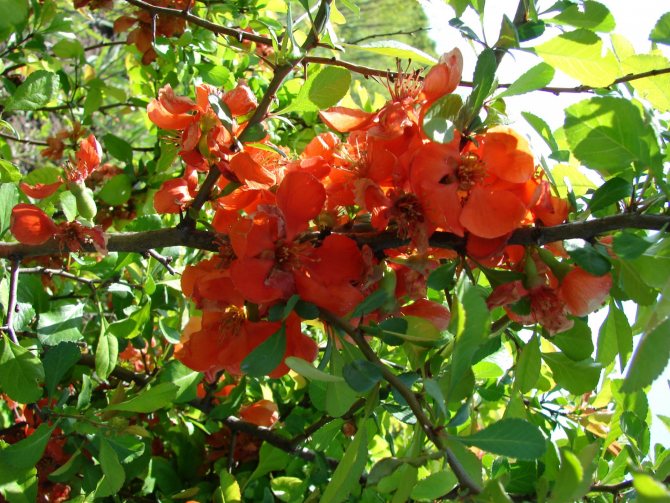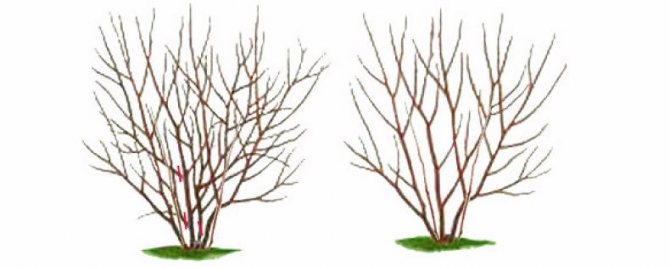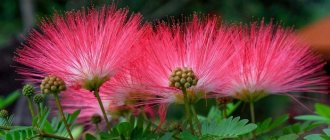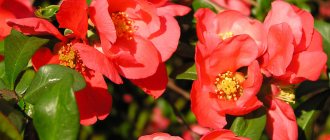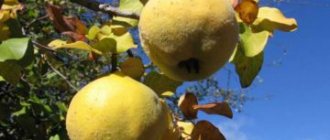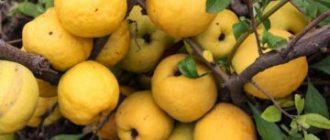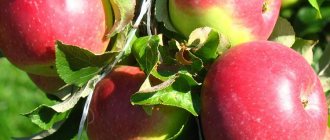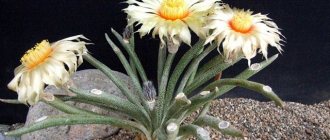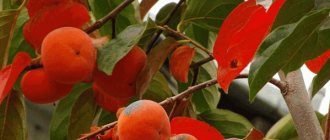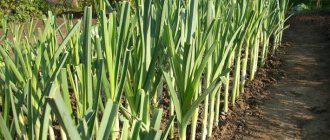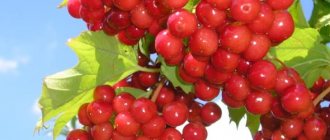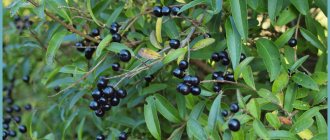Common quince (pictured) is a plant with large edible fruits, it grows in the southern regions. Through the efforts of breeders, varieties with increased winter hardiness were bred, they bear fruit well in the middle lane.
A distant relative of the common quince, henomeles, or Japanese quince, is successfully grown in the Baltic States and the Leningrad region. An unpretentious ornamental shrub in the fall is strewn with small fragrant fruits. In the photo - Japanese quince.
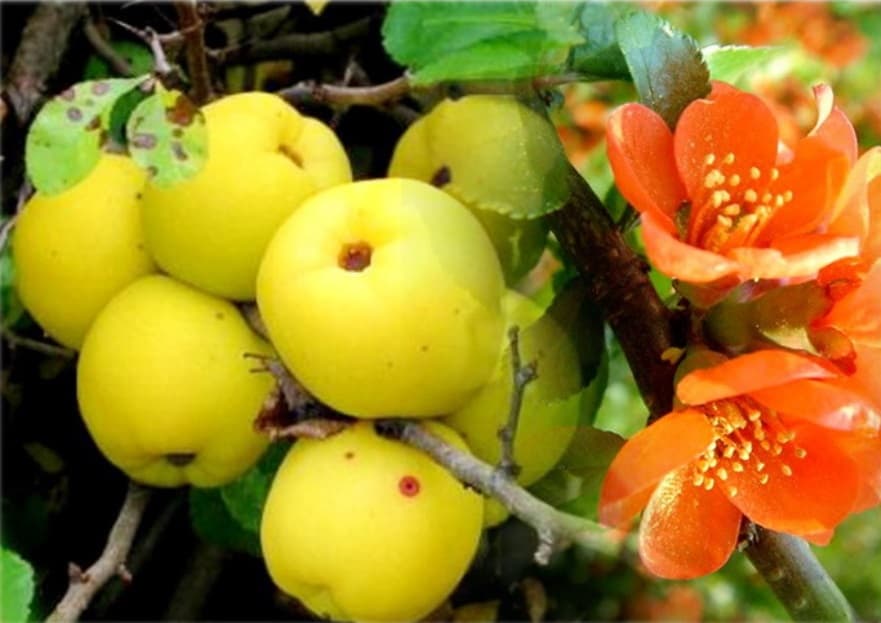
Description of common quince
Common quince (oblong), like the apple tree, belongs to the Pink family. Something similar in these crops and fruits, but in the wild, quince is found only in warm regions: in the Caucasus, Central Asia, in the south of European countries. In gardens, it is grown almost everywhere, including even such northern countries as Scotland or Norway.
What does a quince look like
Quince can look like a tree or a shrub (which is less common), for the winter it sheds its leaves. Depending on the variety and growing conditions, the height can be from one and a half to five meters. Branches rise at sharp angles, forming a broad-oval crown. However, by pruning, gardeners give it a different shape. The trunk and old branches are colored dark gray or red-brown, young shoots are gray, pubescent.
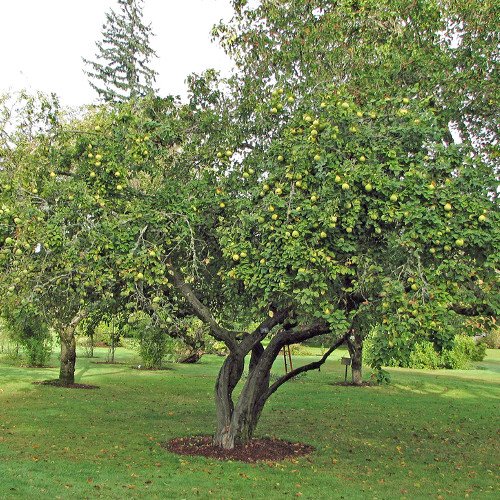

The common quince tree is very similar to the apple tree.
Leaves are often broadly elliptical, but they are also almost rounded. The upper part of the leaves is dark green, the lower, because it is covered with pubescence, seems bluish. The leaves are on two-centimeter petioles, have a length of 5 to 12 cm. Flowers are solitary, open in late spring or early summer. The fruits ripen only in autumn.
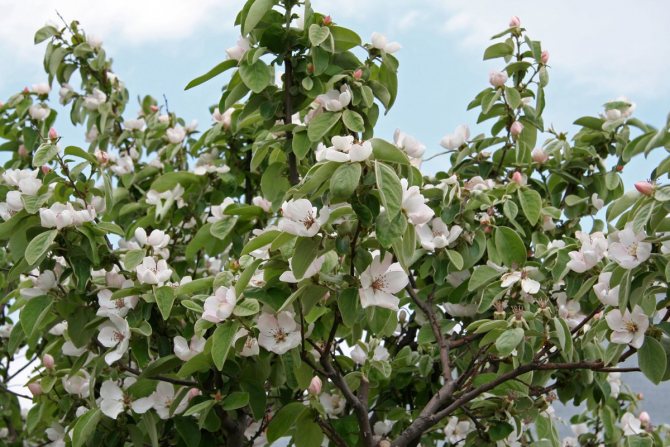

And the flowering of the quince resembles the flowering of the apple tree
Quince lives for a long time, up to 50-60 years, and bears fruit, starting from 3-4 years of age, annually and abundantly. At the same time, the nature of fruiting is gradually changing. If in the first years it is observed mainly on young shoots, then with age, with a decrease in growth, it shifts to fruit branches.
Description of fruits
The fruit of the quince is a false fleecy apple, can have a different shape, usually almost perfectly round or pear-shaped. The color of ripe fruits is from lemon to dark yellow. There are multi-shift nests inside the fruit. The size of fruits in the wild is about 3 cm, cultivars bear large fruits up to 12-15 cm in diameter. The fruits have a bright and strong aroma, but they are quite tough, the juice content is low. Taste - sweetish, but tart and astringent, "for an amateur".
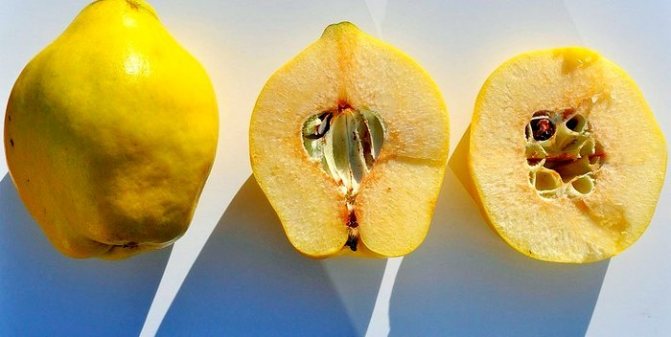

Quince fruits are large, with seeds, hard
In addition to fresh consumption, compotes, preserves, marmalade, and various drinks are prepared from quince. Quince harmonizes well with meat dishes. It is used in folk medicine in the treatment of various diseases, including the gastrointestinal system and respiratory tract.
Muscat
Medium-sized variety, unpretentious in cultivation. Easily adapts to environmental conditions. Grows successfully even on compacted, scarce soils. He is not afraid of frosts and prolonged drought.
Nutmeg quince has a strong immune system - it rarely gets sick. Fruits are of medium size, weight - up to 250 gr. Quince is covered with a dense fluff, similar to felt. The pulp is light beige, fibrous, harsh.The taste is pleasant, sweet with a pronounced sourness.
One tree produces 35-45 kg of fruit. They ripen in September-October.
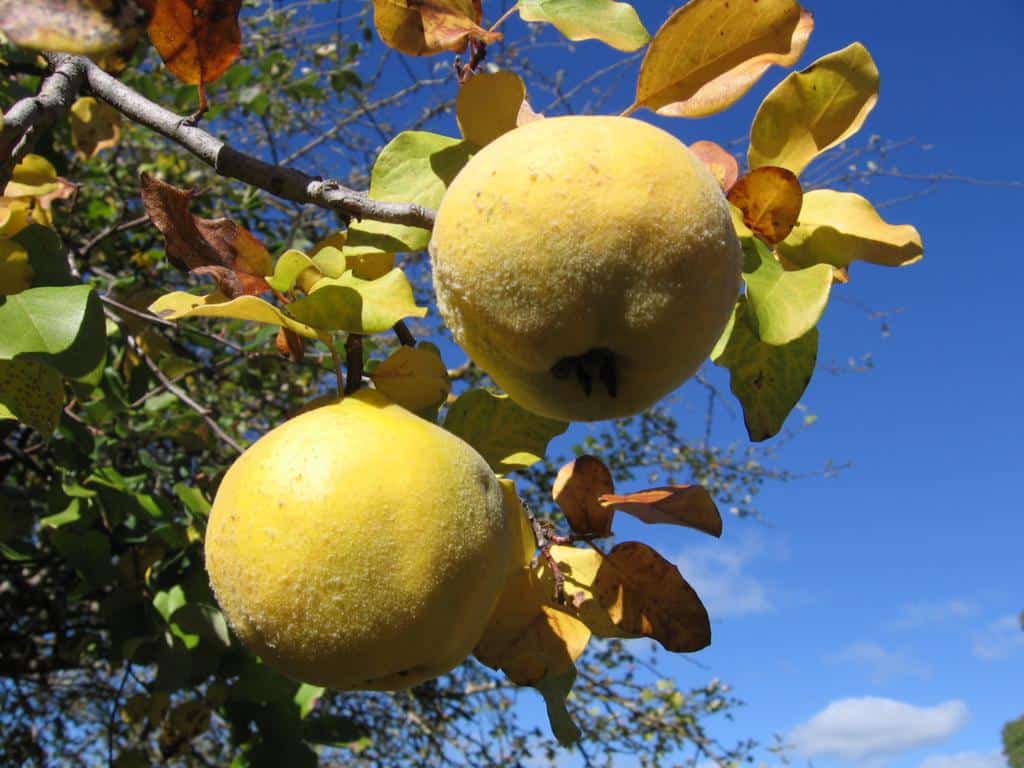

Varieties
There are many varieties of common quince, but only two dozen are registered in the State Register of the Russian Federation, and most of them were bred in the last century. Varieties differ in the shape and size of the fruit, the ways of their use, yield, and also the ripening time. The earliest ones can be partially ready for use at the end of summer, the later ones ripen closer to November.
- Early butter dish. Fruits weighing up to 350 g are lemon-yellow in color, conical-rounded, with yellowish-white flesh. Ripen at the end of September.
- Juicy. Ripening - September. Fruits weighing about 250 g, juicy. The variety is considered to be high-yielding, drought-resistant and frost-resistant.
- Harvest Kuban. Differs in large fruit size (up to 500 g), high yield, resistance to the vagaries of the weather. Early variety, relatively juicy.
- Astrakhan. Ripening is medium early. Fruits are pear-shaped, weighing about 200 g, with dense yellow pulp, sour, tart.
- Beretsky. A mid-season variety of Hungarian origin, partially self-fertile, requires pollinators. Pear-shaped fruits, weighing about 270 g, are considered very tasty: one of the few varieties with a slight astringency.
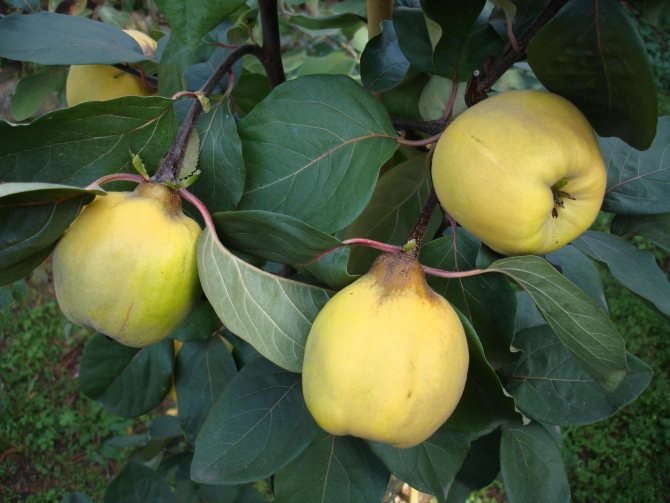

Beretski - pear-shaped foreign variety
- Buinakskaya large-fruited. A variety from Dagestan, ripens very late, but differs in very large pear-shaped fruits (up to 700 g). It is considered one of the most drought and disease resistant.
- Rumo. Quite a popular variety, one of the most undemanding to conditions. Oval fruits grow up to half a kilogram, differ in very weak astringency and high, for quince, juiciness. Ripens at the end of September, high-yielding.
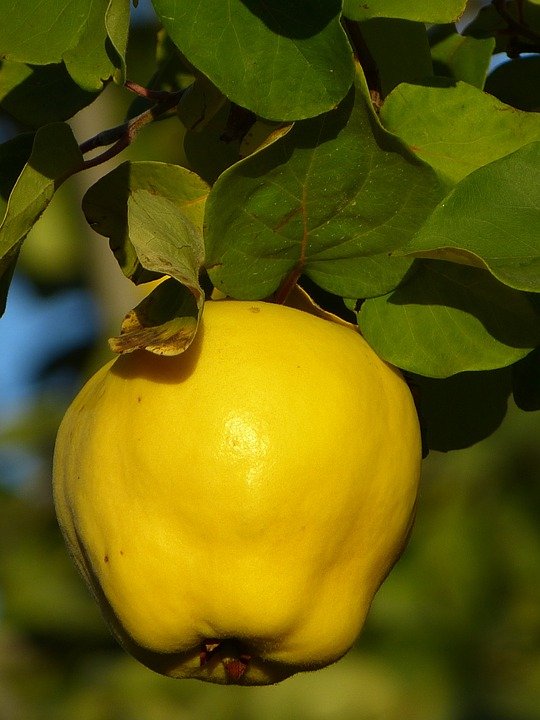

Rumo is one of the most popular varieties
- Codryanka is one of the earliest ripening varieties. Fruits are juicy, weighing an average of 200 g, relatively sweet, universal use.
- North. One of the most winter-hardy varieties. Fruits are small, greenish-yellow, with a felt coating. They have a strong aroma and are relatively sweet.
- Apple. Fruits weighing 200-300 g, similar to apples, lemon-yellow. The pulp is quite juicy, slightly tart, sweet and sour. The variety is late, has good fruit preservation, is characterized by high productivity.
Kuban yielding
As the name implies, the main advantage of the variety is its yield. One tree gives up to 100 kg of fruit. At the same time, the quince is of excellent quality.
Large, juicy, aromatic, sweet and sour. The pulp is a little rough, creamy. Fruit mass - 500 gr. It tolerates low and high temperatures well.
The variety is resistant to pests. The fruits ripen at the end of September. Stored for a long time without loss of presentation.
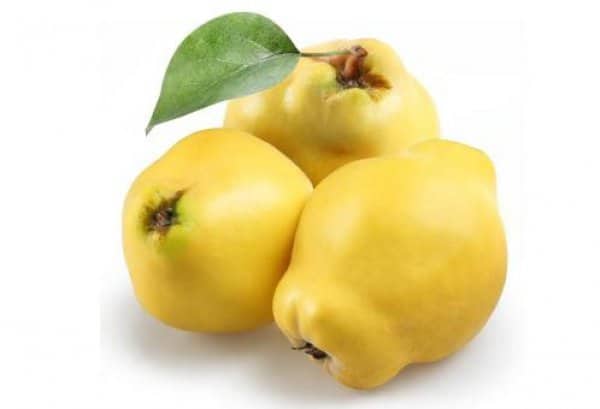

Growing and care
Quince belongs to crops that are relatively easy to grow, but require basic care.
Choosing a landing site and soil
The choice of a place for a quince is simple, but it is important to be guided by the fact that it is still a southern tree, so it is best to plant it in a warm part of the garden, on the southern side of a building. A huge plus is that most varieties are picky about both droughts and boggy soil, they are not afraid of even the close location of groundwater. Quince grows on almost any soil, but prefers heavy ones more: on sandy soils it does not live long, bears fruit poorly.
Quince is planted both in spring and autumn. When planting, it should be borne in mind that the roots of the quince spread far beyond the crown, so you will have to retreat at least 4–5 meters to the nearest tree or structure.
Landing
Quince is planted as one- and two-year-old seedlings, and in recent years, seedlings in containers are often on sale. In principle, they can be planted even in summer, on not the hottest day.Seedlings with bare roots are preferred to be planted in the fall. The planting hole, as for any tree or shrub, is prepared in advance, having previously cultivated the site. When digging it, a little fertilizer is also introduced: about 20 g of potassium sulfate and 500 g of superphosphate per 1 m2. The size of the planting pit is 40-50 cm in depth and up to a meter in diameter.
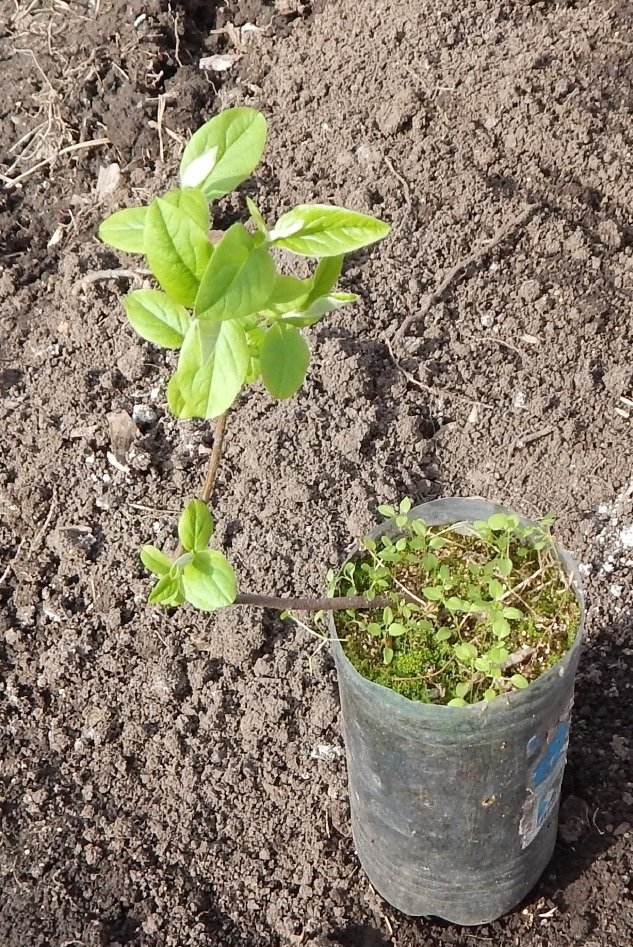

The easiest way is to use a seedling with a closed root system.
Unlike most garden trees, not drainage is placed on the bottom of the pit, but, on the contrary, a layer of clay ten centimeters. Above is fertile soil with 150 g of superphosphate and a glass of wood ash. A boarding stake is also required. The landing technique is conventional. The roots are straightened, gradually covered with soil, without deepening the root collar. Water the quince with at least two buckets of water, mulch with humus or peat.
Spring planting is no different from autumn planting, but all preparatory work is carried out in the fall. In addition, post-plant watering should be given more attention: perhaps the seedling will have to be watered very often (according to the weather): after all, if a layer of mulch of 10-12 cm is poured in the fall (to insulate the roots for the winter), in the spring the mulching layer should be very thin so that the root the neck was on the surface.
How to care for a tree
Quince requires elementary care throughout the growing season. So, in early spring, before sap flow, they carry out sanitary pruning, and in young plants - and formative. When opening the buds, trees are sprayed with Bordeaux liquid, and top dressing is carried out. At the beginning of the extension of the buds, treatment is carried out against pests. Before opening the buds, the quince is well watered.
A week after flowering, the treatment against pests is repeated. In the middle of summer, quince is fed, watering is carried out as needed. The soil is loosened periodically. Treatments with chemicals in the summer are carried out only according to indications, a month before harvesting, spraying is stopped.
After harvesting, spraying with a 5% urea solution is carried out, in November, winter watering is performed. After leaf fall, you can prune: both sanitary and anti-aging. Immediately before frost, the trunk circle is insulated, and in young trees - and the trunks.
Watering features
Most varieties of quince are drought-resistant, but for high-quality fruiting, the culture requires systematic watering (usually 4–5 times per season). Of course, in the first year after planting, watering has to be done even more often. Fruit trees are watered depending on the weather. It is important that the soil is sufficiently moist just before flowering, in the midst of blooming, shortly after flowering and during a period of intense fruit growth.
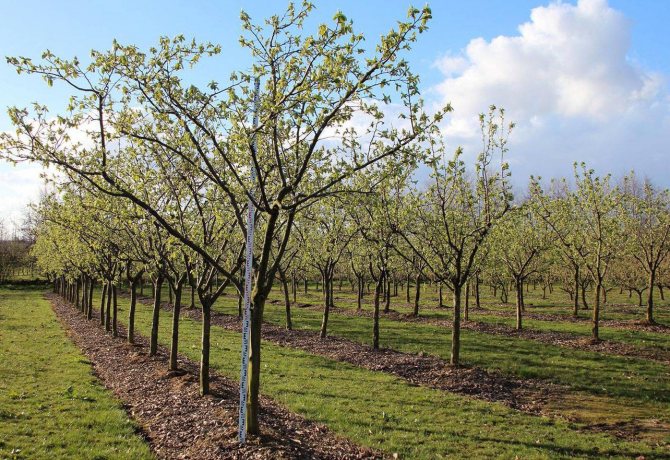

To water less often, quince is often grown using soil mulching.
After watering, loosening and weeding are carried out, especially for young trees. In late summer - early autumn, watering is stopped, but at this time the soil should be moist up to a meter deep. The last - pre-winter - watering is given already in November, the soil is soaked to the greatest possible depth.
Top dressing
In the first 1-2 years after planting the quince, there is enough fertilizer in the planting pit and in the prepared area. Then the tree needs feeding. Organic matter in the form of compost or humus is not applied annually, but mineral fertilizers are required systematically.
The main part of organic matter is obtained by the tree in the form of mulch.
In early spring, urea is scattered and shallowly embedded in the trunk circle (40–100 g, depending on the age of the tree). After the end of flowering, you can add nitrophoska or azophoska (200-300 g diluted). In August, fertilize with phosphorus and potash fertilizers (you can limit yourself to wood ash, a few glasses per trunk circle).
Pruning and shaping the crown
Quince pruning is carried out during the dormant period, that is, in early spring and after leaf fall.First of all, all diseased and dried branches are cut out. In adults, and even more so old plants, thinning and rejuvenating pruning is carried out. Young trees (up to about five years of age) must be pruned in order to properly form the crown. At the end of summer, it is worth pinching young shoots if they are still growing. After leaf fall, they are usually limited to sanitary pruning and, to a small extent, thinning.
Tall varieties are traditionally grown in the form of a cupped tree, cutting out a conductor and leaving 4-5 skeletal branches, evenly spaced around the circumference and spaced 15-20 cm apart in height. Low-growing trees are formed along a sparse-tiered crown of 8-10 skeletal branches ... The height of the trunk in any formation should be no more than half a meter. In general, we can say that pruning of a quince is carried out in about the same way as an apple tree.


The bowl-shaped tree is better illuminated by the sun
Video: shaping the crown of quince
Harvesting
Quince ripens later than all crops in the garden, harvesting occurs in autumn, often even late. They try to let the fruits fully ripen on the tree, but often they have to be removed even unripe if severe frosts come early. Frozen fruits lose their taste and are not stored at all.
Fortunately, the fruits of quince tend to ripen during storage, so there is no trouble in removing a slightly unripe quince.
Late varieties are suitable for long-term storage, which often have to be harvested unripe. Such fruits become ready for consumption about a month after storage in the cellar. The best storage conditions are dry air and a temperature of several degrees Celsius. If there are few fruits, you can keep them in the refrigerator.
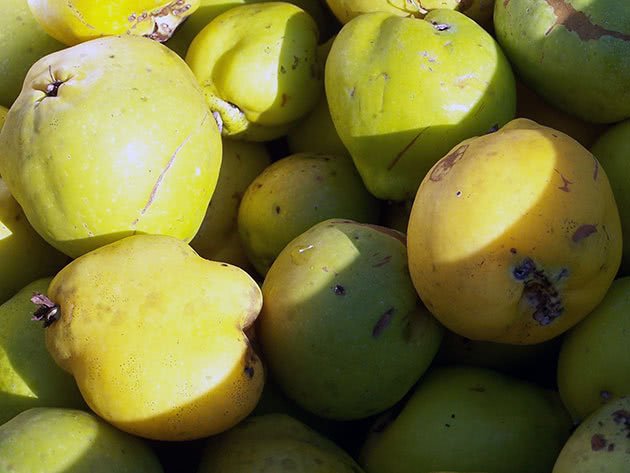

Unripe fruits often have to be removed.
Quince crown formation and pruning
Since the quince is light-requiring, a sparse-tiered formation is recommended for it, providing good illumination of the crown.
On annual quince seedlings, measure the stem (50-60 cm from the grafting site) and count 7-8 buds above the stem. The first tier is formed from 3-4 branches, which are left through the bud at a distance of 10-15 cm from one another.
The second tier is created from single branches located after 30-35 cm or two adjacent branches - after 50-60 cm, thus forming the main branches. To avoid breakage, the main branches should move away from the trunk at an angle of at least 45 degrees.
A two-year-old tree begins to form from the lower main branch, which is shortened by 50-60 cm from the base. The rest of the main branches are pruned at the same height. The conductor is cut 20-25 cm above the level of the main branches.
The main task of the first years of formation is to select the branches of the second and third orders necessary to create a solid base for the tree. The first branch of the second order is laid at a distance of 30-40 cm from the tree trunk, the second - at a distance of 30-40 cm from the first on the opposite side. The continuation shoots are cut off, subordinating them to the branches of the first order.
During initial fruiting, pruning consists of shortening and thinning. By the end of the full fruiting period, partial rejuvenation of the crown is applied. For this, the main and overgrowing branches are cut into 2-3-year-old wood.
Diseases and pests
Unfortunately, quince is not one of those crops that can be grown without spraying. And if she gets sick infrequently, then pests are often a significant problem.
Causes of diseases and their treatment
Quince diseases occur with poor care and unfavorable weather. So, moniliosis usually attacks in too damp weather. First, brown spots appear on the damaged fruits, then they increase, the pulp looses, the fruits fall off. With the stormy course of the disease, it goes on to completely whole fruits.Treat the disease with fungicides: Bordeaux liquid, Rovral, etc.
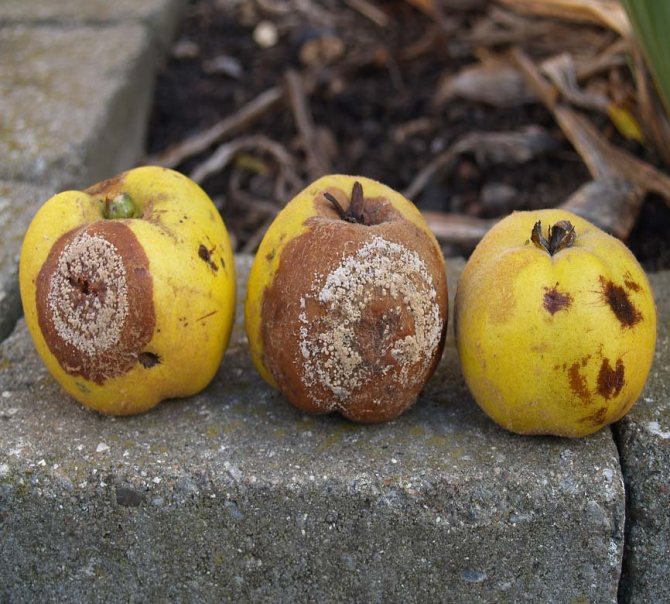

Moniliosis often affects stone fruits, but quince is also afraid of it.
The same drugs are used against the brownishness of the leaves, as well as powdery mildew. Dew usually appears first on annual shoots in the form of white or brownish spots, then the spots turn into a brown film with black dots. Subsequently, the shoots cease to grow, the leaves are deformed and the ovaries crumble. Fungicides are used two weeks after flowering, and then again a month later.
The fungus is also to blame for the rotting of the ovaries, which begins with blackening of the leaves, and then moves on to the buds and flowers. The ovaries are formed, but they quickly rot and fall off. Spraying with Fundazol can serve as prophylaxis.
Major pests
A group of leaf-spoiling pests is called leaf-dominating moth. Since the plant weakens significantly, the harvest is lost, the winter hardiness of the tree deteriorates. Against moths, Fundazol or Dipterex are effective, applied after the end of flowering.
Young stems and buds often infect red and brown fruit mites. Their larvae suck out the juices of the plant. Prevention of invasion - spraying with a 7% urea solution during leaf fall. When ticks appear, Fitoverm is used, for example.
Aphids harm the quince in the same way as the apple tree, sucking juices from young shoots and leaves. She can also carry pathogens. You can also fight aphids with folk remedies (soap, ash, various herbs), but with a large amount of pest, you have to use the same Fitoverm or Biotlin.
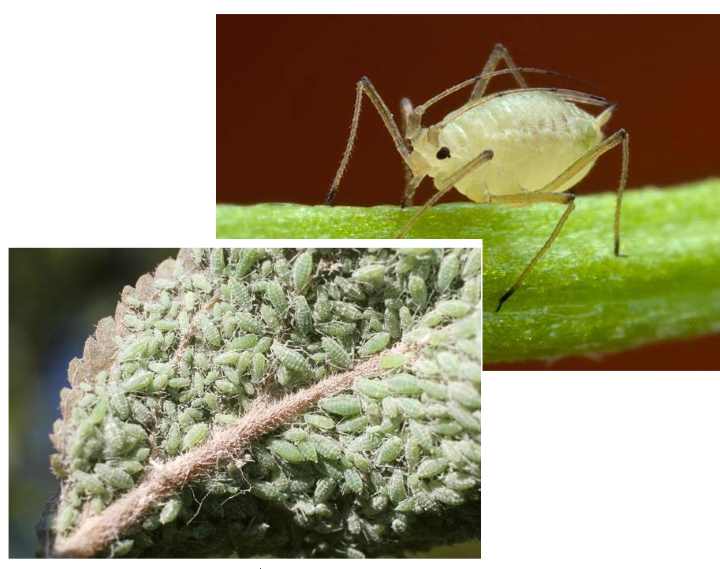

Aphids and other pests are just as terrible for quince as for apple tree
The apple moth is a well-known "worm" that spoils the fruit. There are many means to combat it, it is better to give preference to biological agents like Bitoxibacillin.
Teplovskaya
The variety was obtained in Astrakhan. The breeders wanted to develop a quince that is resistant to low temperatures and yields good yields. They succeeded. The tree is not afraid of cold weather. Produces yellow fruits resembling apples. The sizes are different - from small to large. The pulp is juicy, dense, aromatic. The taste is sweet and sour. Stored up to 4 months.
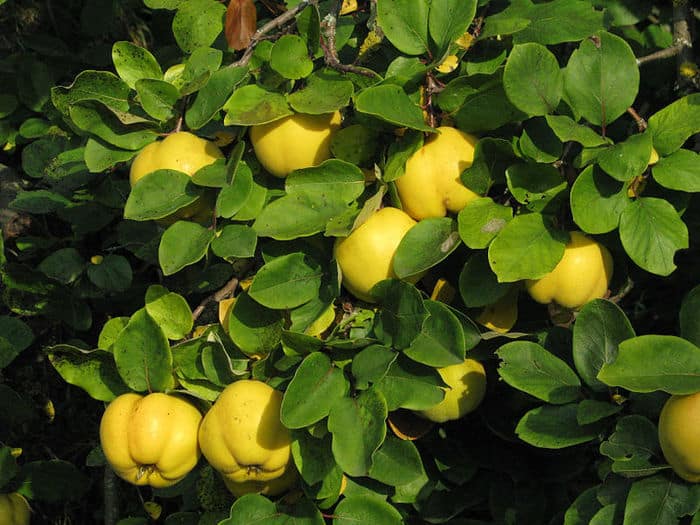

Here are 10 of the best varieties. Everyone is the perfect candidate for growing. They are resistant to low temperatures and drought, are practically not affected by fungi, give juicy and tasty fruits that are distinguished by high commercial qualities and can be stored for a long time.
Reproduction
Quince can be propagated in various ways, all of them are to one degree or another simple.
Seed reproduction
The seeds are extracted from fresh, fully ripe fruits. After washing, they are well dried, and then sown before winter. Sowing depth - 2-3 cm. For the winter, crops are covered with peat or humus. In spring, seedlings are thinned out, ultimately leaving 15–20 cm between them. By autumn they grow to 35–40 cm and can be transplanted to a permanent place.
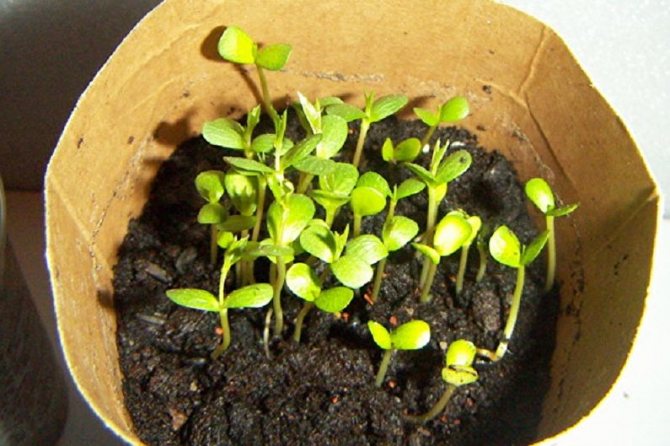

Sometimes seeds are even sown in a pot; their germination is excellent
Reproduction by layering
Quinces are propagated by layering in the same way as currants, only you need to find low-lying branches that can be pinned to the ground. The top is taken out. A vertical sprout may emerge from each lateral bud. When they grow up to 15–20 cm, they huddle up. All summer long the soil is well watered and loosened, and after leaf fall, they are divided into seedlings and planted.
Cuttings
Reproduction by cuttings is somewhat more difficult, since it is necessary to use growth stimulants and carefully monitor soil moisture. Otherwise, there are no problems. You can use both green and lignified cuttings. Cuttings with 1-2 internodes are planted in a substrate of sand and peat (3: 1), preferably in a greenhouse. The roots appear in a month or later, but usually by the fall the seedlings are ready for transplantation.
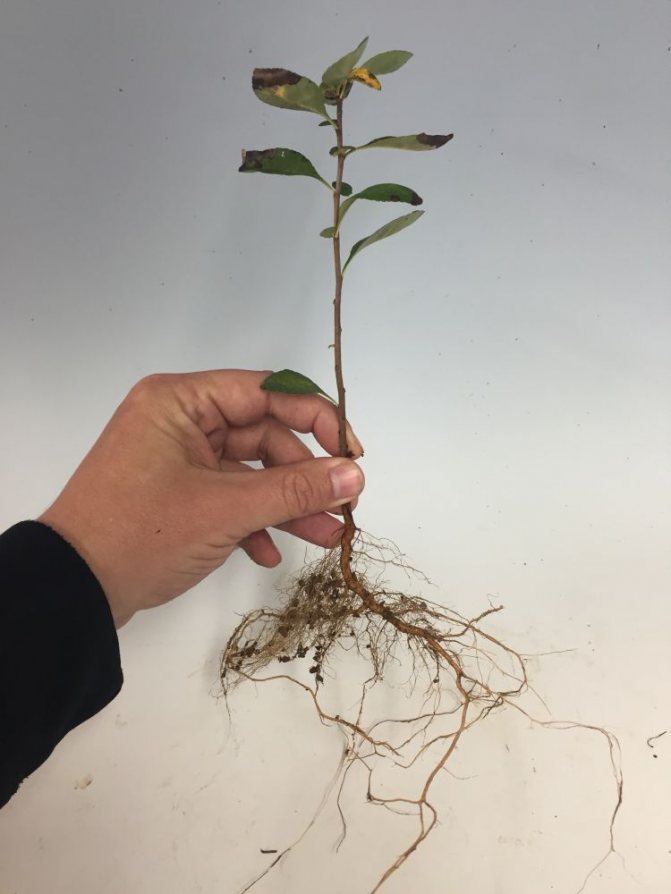

If everything goes smoothly, the roots of the cutting will grow very quickly.
Root shoots
Roots are not the best way to reproduce, although they are the easiest ones. Usually the shoots are destroyed, but if the strongest specimens are huddled several times over the summer, they may well grow a good root system. As a rule, good plants can be obtained from such seedlings.
Graft
Usually the most valuable varieties are propagated by grafting. Cuttings are grafted onto wild birds, quince grown from seeds or hawthorn. Vaccination is carried out in the same way as in the case of an apple tree. In addition to the spring grafting with a cuttings, the August budding is also used.
Video: reproduction of quince
Quince care
During the cultivation of quince, its bushes, when forming and pruning, should have branches almost parallel to the surface of the earth; their height is about 50 cm above the root collar. The thickening of the bush must not be allowed, the maximum number of branches on one plant is 10-15, of which 2-3 are at the age of 4 to 5 years, 3-4 branches are three-year-old, the same number of two-year, the rest are annual.
Quince is annually cut out five-year old branches with low productivity and dying growth. Strong growth of vertical top-type shoots should not be allowed, they are pinched as they appear or completely cut out before the buds awaken. It is best to do this in the spring, as autumn pruning reduces the winter hardiness of the bushes. The weakened branches in contact with the soil are cut every spring.
Harvesting of quince begins in the third decade of September, before autumn frosts. Large, well-ripe fruits are stored until early February at a temperature of + 2 ... + 3 ° C.
Quinces are usually planted in the spring before a green cone appears on the buds.
Common quince in landscape design
During flowering, quince looks very beautiful, and therefore it is often used to decorate parks, alleys and squares. However, more often Japanese quince is used for this purpose, which is a slightly different species and is almost always grown in the form of a bush.
Photo gallery: quince in design
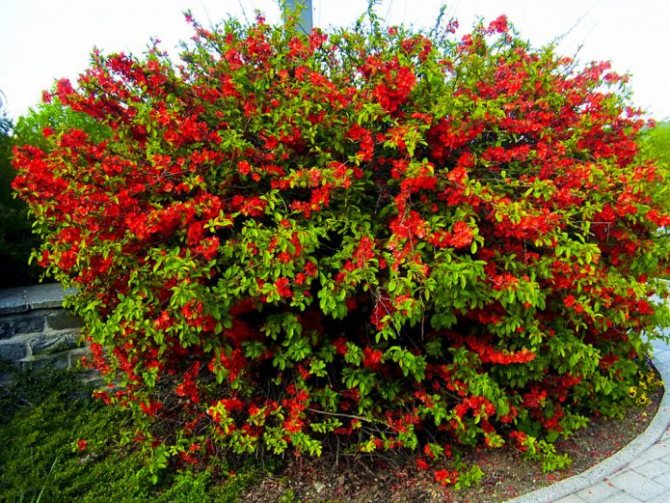

Japanese quince can be planted as a separate bush
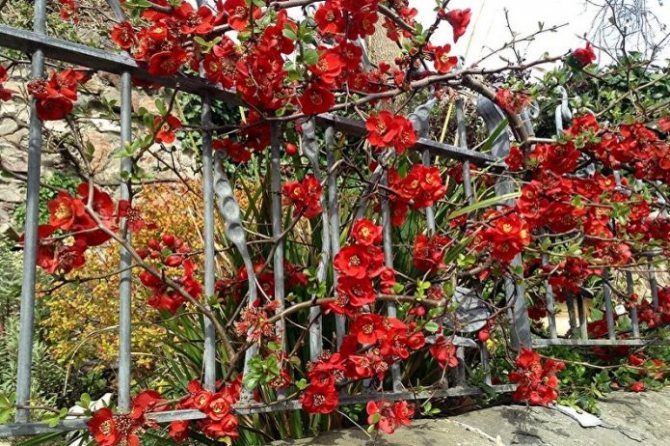

Shrubby quince can be used to make a wall
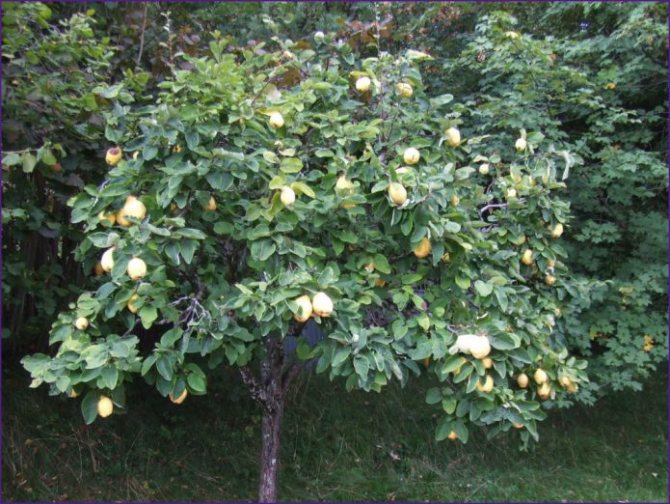

The common quince tree looks good among other tree species
Common quince is a fruit tree that bears fruits similar to apples, but harder and more tart. Quince can be found not in every garden, but there are many fans of this culture.
Growing Japanese quince from seeds
Many gardeners propagate Japanese quince by sowing the seeds of this plant before winter. For the largest and ripe fruits, seeds are selected immediately before sowing. In the last days of October, the planting material is laid out in holes to a depth of 1 cm. There should be a gap of 15 cm between the rows. For normal growth, the seeds are laid out at a distance of 5 cm from each other. The plantings are mulched with peat or humus, which is slightly compacted. With such a planting, quince shoots will appear in May.
If Japanese quince is grown for fruit, it should be planted in a sunny area. In a shaded place, the bush will bloom, but the plant will not tie the fruit.
You can grow Japanese quince seedlings at home. Until January, the ripe fruits of the Japanese quince are stored in a cool and dry place. Seeds are harvested from ripe large fruits. At the end of January, quince seeds are mixed with wet washed river sand in a ratio of 1: 3 and placed in a plastic bag. In order for the seeds to breathe, several holes or punctures are made in the bag. Further, the seeds of quince are laid for stratification in the refrigerator for 2-2.5 months. The bag is kept at a temperature not exceeding 5 ° C at a relative humidity of 70%. The optimal place for stratification is the refrigerator. Periodically, the sand with quince seeds should be moistened, making sure that no mold forms on it.
In March-April, Japanese quince seeds are sown for seedlings. For planting, non-acidic soil is used, the pH of which is no more than 6-7 units. Seedlings obtained by seedlings grow up to 40-50 cm by autumn.When planting in open ground, quince seedlings are planted to a depth corresponding to the depth of the seedling box or pot. A distance of at least half a meter is left between the seedlings, and the row spacings are located at a distance of 2 meters from each other.
Useful properties of Japanese quince
Japanese quince consists of more than 5% organic acids, contains about 2% tannins. Chaenomeles fruits have more vitamin C than lemon, it is preserved during heat treatment. Therefore, products from quince fruits are used as a means of preventing seasonal viral diseases. Quince contains vitamins: B1, B2 and P; pectins and trace elements: phosphorus, potassium and calcium.
The pectins contained in the fruits contribute to the removal of heavy metals and toxins from the blood, which is very useful in poor ecology. Fresh quince juice has a beneficial effect on atherosclerosis, anemia and hypertensive problems. Chaenomeles lowers blood cholesterol levels, strengthens the walls of blood vessels.
A decoction of quince seeds reduces inflammation of the mucous membrane of the eyes, stops bleeding; lotions treat burns and skin irritation.
A flowering plant with its colorful appearance in itself raises the mood, and the products of fruit processing will increase the tone of your body.
Homeland of quince: origin and history of use in culture
The plant is one of the oldest fruit crops known to mankind for over 4000 years. The Caucasus is considered the birthplace of quince, from where it came to Asia Minor and further to Ancient Greece and Rome. Already at the beginning of the last millennium BC. These fruit trees grew in abundance on the island of Crete, some historians believe that the name of a kind, Cydonia, quince received from the Cretan city of Sidon.
The first written mentions of the culture appear already in 650 BC, according to the ancient Greek legend, the golden apple presented by Paris to the goddess Aphrodite was the quince fruit.
According to Plutarch, fruits with their sweetness and tartness were considered at that time a symbol of any marriage, and were necessarily used in various rituals associated with the ceremony of marriage.
The ancient Greeks called the plant Melon Kydaion, it is with this name that the second version of the origin of the genus name is associated.
From Greece, quince goes to Italy. A detailed description of it is found in the writings of Pliny, who already in 75 BC. 6 varieties of this fruit tree were known, which was used not only for food, but also for medicinal purposes.
Evidence of the popularity of the fruit in ancient Rome is the first cookbook of the famous Roman glutton Apicius, which describes a recipe for making a dessert from quince. Pictures with images of culture are found on the walls of destroyed Pompeii, the image of a tree is present in the paintings of that period.
Blooming quince in the photo
Quince flowering time - May-June, duration - about 3 weeks. Flowers are single, large, up to 5, 5 cm in diameter, pink or white with yellow stamens, with short, downward pedicels.
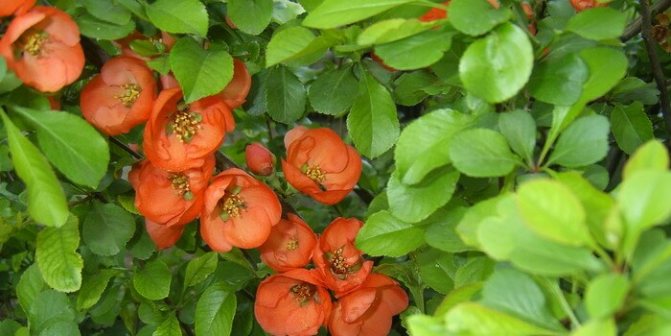

Unlike other pome crops, they appear on the lateral branches of the generative shoots of the current year, therefore they bloom late, after the leaves appear.
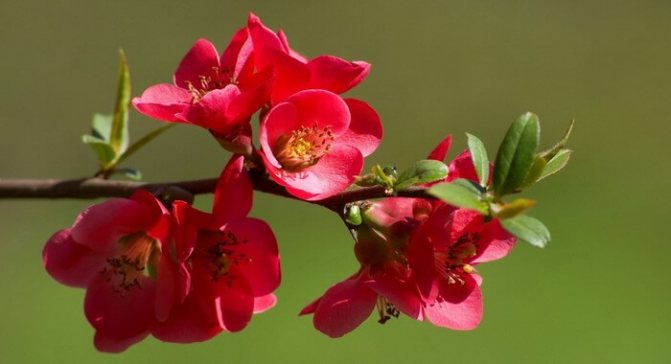

Due to this feature, quince flowers are usually not affected by recurrent spring frosts, and fruiting occurs annually. Blooming quince (pictured above) is very decorative, in late spring flowers abundantly cover the branches from top to bottom and serve as a real decoration of the garden.
When the walnut ripens. When walnuts ripen, when can they be harvested
.
Walnut is a nutritious product rich in proteins, vitamins, and has excellent taste. In order for the fruits to bring maximum benefit and to be stored for a long time, it is necessary to collect them at the right time, for this you need to be able to determine when the nuts are ripe.
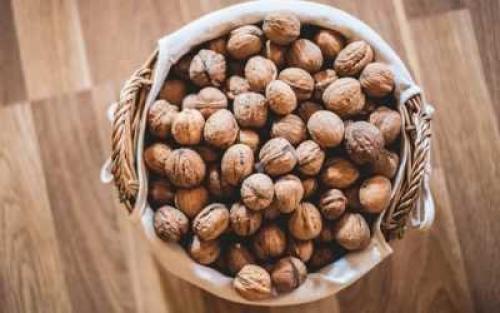

Walnut is a nutritious product with excellent taste characteristics
Ripening time of nuts
Walnut trees grow in Greece, India, Turkey, Ukraine and central Russia.
Depending on the climate of the growing zone and the variety of walnuts, ripening occurs from August (for early ripening) to October (for late ones).
Most varieties reach maturity from late September to early October. By this time, the shell is cracked and the fruits fall to the ground.
Wait for the final ripening, this is the optimal time when it is better to collect walnuts. If it is difficult to determine the ripening period, remember that early harvest is less unprofitable than late harvest.
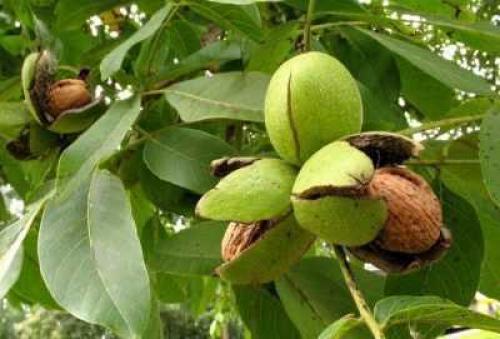

Walnuts must be harvested after they are fully ripe
Determination of readiness of nuts for harvest
The time when walnuts are harvested and the quality of their kernels are directly related. Harvesting early before full maturity will shrink and shrink the edible kernel.
If all the nuts are harvested ahead of time, you can put them in a wooden box for 2-3 weeks and then dry them. Harvesting too late is fraught with fruit rotting and pest damage.
To correctly calculate the time when walnuts ripen, you need to be guided first of all by their variety.
How to determine the ripeness of walnuts:
- Fruits with a cracked green pericarp are fully ripe and ready for harvest.
- A nut that is ripe begins to fall to the ground.
- The membranes between the halves of the nucleus are dark brown, and the nucleus is light and well-defined.
Basic rules for collecting walnuts
Fruits on the same tree become ready for harvesting at different times: those that grow on the branches closest to the ground ripen faster. Harvest the entire crop in 2-3 doses for 1-2 weeks.
To collect all the fruits in one go, you will have to pluck or knock them down with a whole pericarp (green shell). In this case, they should be left in a bucket or box to ripen. It is unacceptable to store nuts together with fully ripe ones.
If the fruits do not crumble, but the shell is cracked, you should pick them by hand or knock them down with a stick. If the nut is difficult to release from the shell, you can cut it off with a knife. Another way to easily get rid of the pericarp is to soak the fruits in water. It is better to pick nuts with gloves, as the green peel leaves persistent brown stains.
In order to avoid an increase in the temperature inside the fetus and its deterioration, it is recommended to clear it of the pericarp immediately after collection. Nuts must be harvested no later than a day after falling to the ground, and in rainy weather no later than 12 hours. Many people try to store fruits that have lain in the ground for several days, but this cannot be done, since they can be affected by mold.
When knocking walnuts off a tree, care must be taken so as not to damage the fruit-bearing branches and bark, otherwise this will have a bad effect on subsequent harvests. Collecting walnuts, hazelnuts and other fruits from the ground is simplified by special devices - roll tools and machines that send the collected products to containers. There are also devices that cleanse the nut from the pericarp, which significantly saves time and effort.
Drying walnuts
The nuts may taste bitter immediately after picking, but after drying, the taste disappears. Dry the fruits in a dry room or outdoors on sunny days, placing them in one layer and turning them periodically.
It is recommended to dry wet nuts on wire nets to allow the water to drain off. Drying fruits on the stove or in a hot oven will lead to a loss of taste, damage to the fruits. Drying in the oven at a maximum temperature of 60 ° C is allowed, but in this case the shelf life is reduced to six months.
Before drying, walnuts are cleaned of dirt and debris. Usually, 5-6 days are enough for the fruits to dry well and can be stored without losing their beneficial properties for up to 2 years.For longer storage, you can use the following method: place the fruits for 8 hours in boiled salt water, and then dry.
Dried walnuts should be stored in cloth bags or nets at a temperature of about 15 ° C and a humidity of no more than 70%. A balcony is not suitable for these purposes, and a darkened dry place, like an attic, is the best option. Peeled kernels can be stored in a refrigerator in a glass jar for up to 6 months, after having previously calcined them in a low-temperature oven to kill germs.
Planting chaenomeles
The best period for planting Japanese quince is spring, when the ground has already thawed, and the buds have not yet blossomed. A biennial plant planted from a container with closed roots takes root well. It is not advisable to plant quince in the fall, it loves warmth and may die before it really takes root. The plant also does not like frequent transplants, so it is better to immediately find a permanent place for it.
Seat selection
When grown, the heat-loving Japanese quince prefers sunlit places, closed from the wind. It is better to choose a corner for her on the south side, well illuminated by the sun, since in the shade the plant blooms poorly and develops poorly.
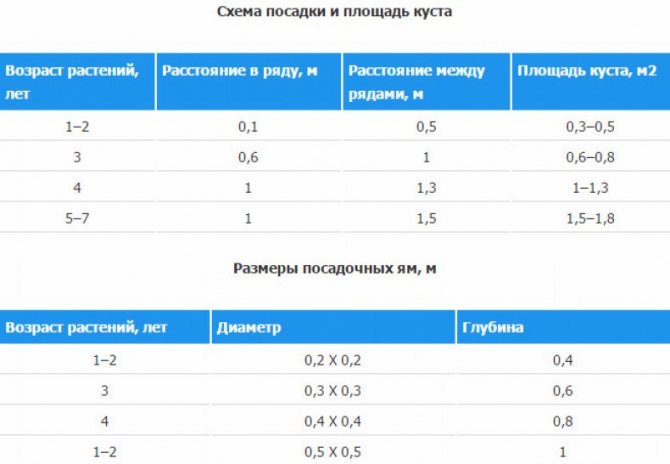

Preparing the soil for planting
It is not difficult to grow Japanese quince, it grows well on almost any soil, with the exception of peaty soils. The main requirement for the composition of the soil is the absence of salinity and lime inclusions. Chaenomeles grows best on soil that has good drainage, fertilization and moderate moisture. Beware of planting the plant on alkaline soil - chlorosis of the leaves will appear. The plant is resistant to dry periods, although at an early age, after planting, it needs moisture, but without moisture stagnation. Before planting Japanese quince, you need to clear the soil of weeds, poor and heavy soil must be "diluted" with leafy soil and sand, fertilized with peat-manure composition, as well as phosphorus additives.

